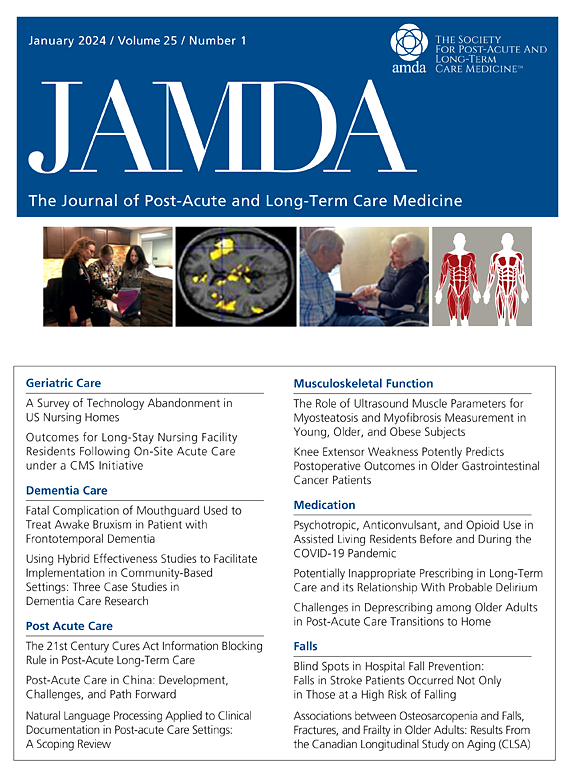Deep Dissecting Hematoma, an Often Misdiagnosed Lesion: Case-Control Analysis of Risk Factors and Wound-Healing Prognosis
IF 4.2
2区 医学
Q2 GERIATRICS & GERONTOLOGY
Journal of the American Medical Directors Association
Pub Date : 2025-04-04
DOI:10.1016/j.jamda.2025.105569
引用次数: 0
Abstract
Objectives
Deep dissecting hematomas (DDHs) represent severe acute wounds, predominantly affecting older patients. This study aimed to identify DDH risk factors and analyze factors associated with good wound-healing prognosis.
Design
Retrospective, multicenter, case-control study from January 2016 to March 2022.
Setting and Participants
A total of 240 patients, 60 patients with DDH and 180 controls with venous or arterial ulcers.
Methods
Primary endpoint was analysis of demographic and clinical parameter differences between patients and controls to identify DDH risk factors. Secondary endpoint was analysis of DDH-wound healing to identify factors associated with good prognosis defined as ≥40% healing of the initial wound 1 month after debridement.
Results
Patients were mainly female (n = 47, 78%), 63% misdiagnosed, median age: 87 years, and median Cumulative Illness Rating Scale (CIRS) score: 20/56. The low limb was the main DDH localization. Thirty-three (55%) patients had dermatoporosis, 53 (88%) were malnourished, and 51 (85%) had peripheral vascular disease. DDH developed post-trauma in 42 (70%) patients, with 29 (48%) of them resulting from falls. Half of the patients experienced DDH complications: acute anemia (n = 31, 52%) and local infection requiring oral antibiotics (n = 22, 37%). Time to starting appropriate care was significantly longer when the first DDH consultation was outside our expert center. DDH was significantly associated [adjusted OR (95% CI)] with low-molecular-weight heparin [1.95 (5.12–92.1); P < .001], dermatoporosis [3.75 (1.63–9.04); P = .002], age [1.09 (1.02–1.17); P = .02], and CIRS score [1.08 (1.01–1.17); P = .05]. Chemotherapy was significantly associated with delayed wound healing (P = .03) and age (P = .04) and skin grafting within 1 month (P = .003) were significantly associated with good wound healing.
Conclusions and Implications
This analysis of DDH risk factors based on a case-control study of a large geriatric cohort identified novel results on prognostic factors for DDH healing. Larger prospective studies are needed to extend our findings.
求助全文
约1分钟内获得全文
求助全文
来源期刊
CiteScore
11.10
自引率
6.60%
发文量
472
审稿时长
44 days
期刊介绍:
JAMDA, the official journal of AMDA - The Society for Post-Acute and Long-Term Care Medicine, is a leading peer-reviewed publication that offers practical information and research geared towards healthcare professionals in the post-acute and long-term care fields. It is also a valuable resource for policy-makers, organizational leaders, educators, and advocates.
The journal provides essential information for various healthcare professionals such as medical directors, attending physicians, nurses, consultant pharmacists, geriatric psychiatrists, nurse practitioners, physician assistants, physical and occupational therapists, social workers, and others involved in providing, overseeing, and promoting quality

 求助内容:
求助内容: 应助结果提醒方式:
应助结果提醒方式:


